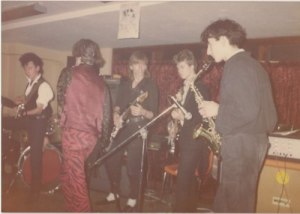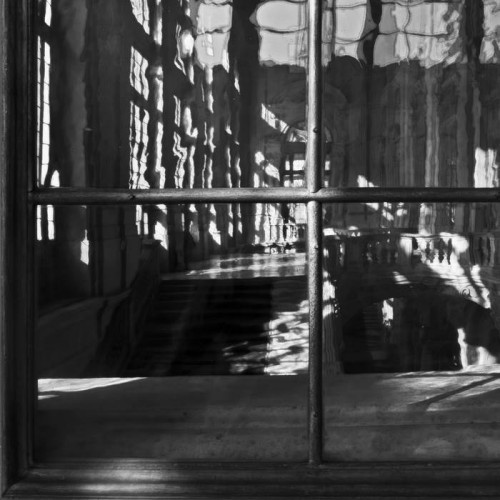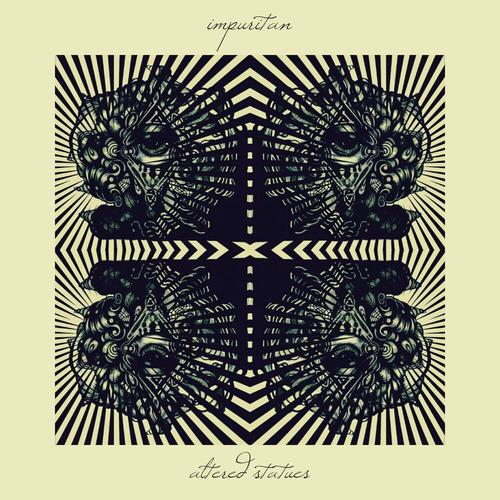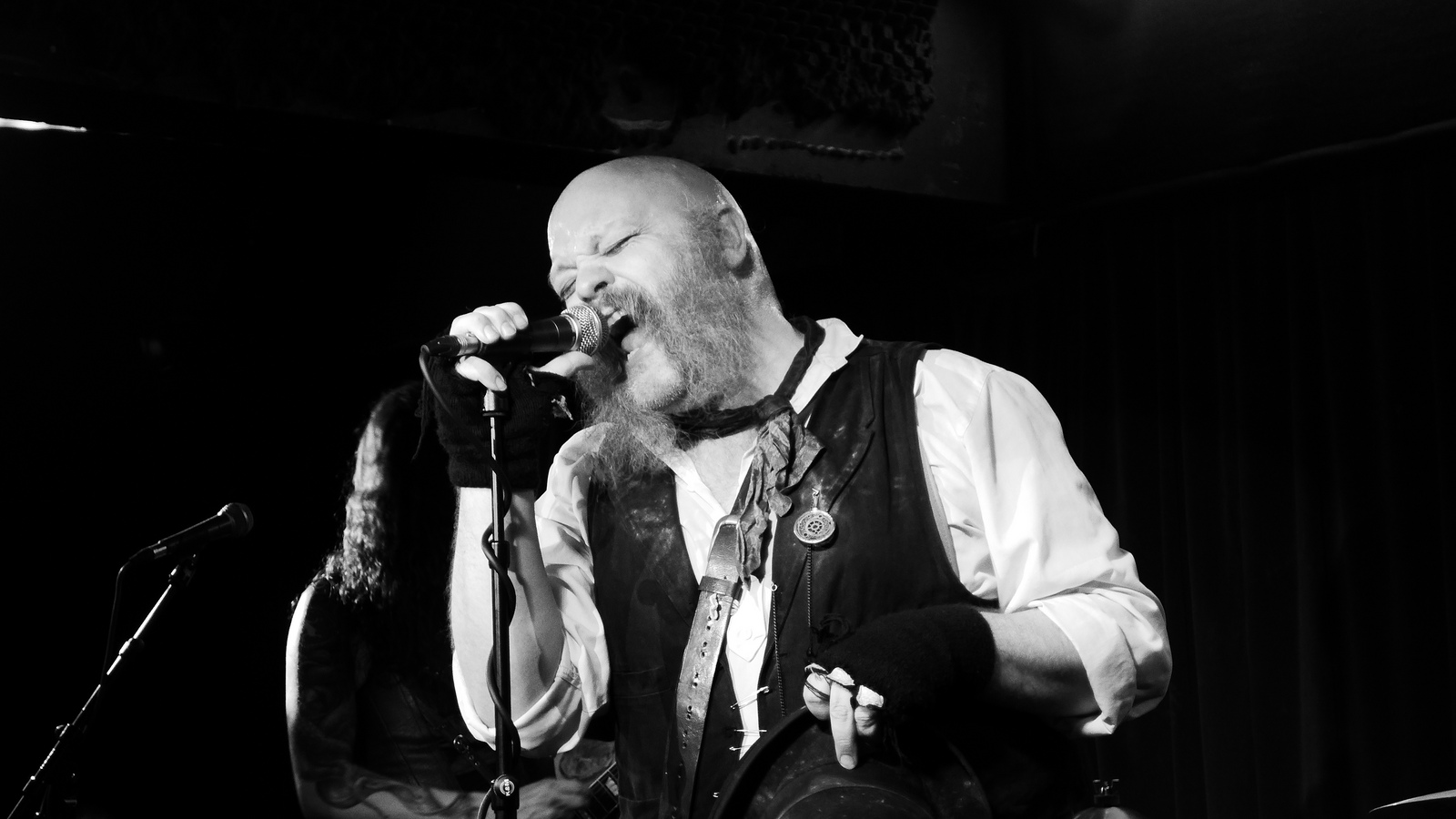Louder Than War Books / Manchester University Press
 Once upon a midnight dreary, while I pondered, weak and weary,
Once upon a midnight dreary, while I pondered, weak and weary,
Over many a quaint and curious volume of forgotten lore—
While I nodded, nearly napping, suddenly there came a tapping,
As of someone gently rapping, rapping at my chamber door.
“’Tis some visitor,” I muttered, “tapping at my chamber door—
Only this and nothing more.”
Ah, distinctly I remember it was in the hot July;
When joyous picnics quickly go awry with wasps impossible to ignore.
Eagerly I wished the morrow;—vainly I had sought to borrow
John Robb’s new book of sorrow—sorrow for the genre Gothic—
Wherein all the bands explored at length the Goth tag do much abhor—
Captured here for evermore. i
Right, crimp up your hair, slap on the panstick, suck in your cheeks, this is going to be a bumpy ride…
~
A proper overview of Goth is probably at least a decade overdue. The first band who could arguably merit the tag as exponents rather than just forerunners (and more about them later…) trod the boards around forty-five years ago, and music writing has proved distinctly tardy around giving the phenomenon some decent examination and analytic heft.
In an era when the bookshelves of major retailers are fair groaning under the weight of mighty tomes covering the minutiae of everyone from EMF to The Shaggs, it seems curious that a movement that encompasses such revered names as Bauhaus, Siouxsie And The Banshees, The Sisters Of Mercy and The Cureii seems to have remained so impervious to criticism for so long.Critics, too, have artfully sidestepped the genre and there remains a lingering suspicion that many – even those seen as its leading lights – see Goth as somehow infra dig. Quite why is open to debate. Too serious? Well, the ranks of books about Prog are proliferating quietly, so it can hardly be that. Too flippant? You think the best-seller about Mötley Crüe was a study of their complex chord progressions? Too juvenile? Too ephemeral? Too long ago? Well, there’s hardly any description which could be applied to Goth which couldn’t equally well be applied to the myriad other genres the histories of which today’s scribes are even now furiously bashing out words around.
Like black lipstick (possibly the ne plus ultra of Goth fashion), the genre just seems off-putting to many, an instigator of fear or unease, the way some find mushrooms or toadstools unsettling even though they are fascinating little miracles of nature. When it manifests as a slight antipathy to Gene Loves Jezebel, it hardly seems like the end of the world, but when it leads to murder – as it did, for example, in the case of the tragic Sophie Lancasteriii – one must think there is something more psychologically profound at workiv.
John Robb, however, is made of sterner stuff. No shying away from the shadows for he, no keeping the night light on at bedtime. Giving a hefty toll of the bell, he has instead decided to kick open the doors of the temple of love and release the bats. And how.Once the curtain has thus been raised, there follows a dazzling series of thumbnail biographies of all the key players, some longer, some shorter, from the early post-punk and alternative days in London and the north of England, to the genre’s mid-Eighties point of commercial breakthrough, to its later efflorescence and mass acceptance in America and beyond.
And boy, everyone is here: The Banshees, The Damned, Adam Ant, Joy Division, The Cure, Bauhaus, Killing Joke, Nick Cave, The Cramps, The Sisters… draws a deep breath… Einstürzende Neubauten, (Southern) Death Cult, Theatre Of Hate, Dead Or Alive, The Virgin Prunes, Laibach and more. Many, many more.We get a particularly strong sense of place, with a keen dissection of the differences between London and the northern cites such as Leeds and Manchester (probably even more distinct in those days) brought to the fore; we get a flavour of the changing economic climate and cultural morés either side of the 1979 watershed; and we get a real sense of the dramatis personae, probably the strongest one will find outside any biography dedicated to an individual subject.
Ian Astbury, for example, who many in the ‘alternative’ scene came increasingly to see as rather a clichéd embarrassment with his ascendancy into stereotyped rock antics as The Cult broke into the Zeppelin-esque stadium big time, comes across as an articulate, witty, likeable and astute observer of the times and the music. Pete Burns underachieved so badly after the mid-1980s that the British public will likely know him mainly for his appearance on I’m A Celebrity, Get Me Out Of Here rather than for being a genuinely outré prime mover on the Liverpool scene. And Adam Ant, whose post-Eighties travails with mental ill health have threatened to become more written about than his actual music, is returned to the status of an originator and innovator, admired by and influential on his peers.Simultaneously though, this comprehensive approach is also a fundamental problem. With no attempt to define the term ‘Goth’, the book seems both lacking any kind of yardstick with which to judge inclusion or exclusion, or any way to discriminate what is Goth from what is merely dark or alternative. If it were the latter, as the title might suggest, then there may have been a case for including many bands covered here, Laibach for instance. However, the cover blurb indicates in no uncertain terms that this is “the first major overview of Goth music and culture, exploring both its legacy and influence”.
That is a pretty unambiguous mission statement, and one that becomes increasingly hard to reconcile with some of the inclusions. My love for Laibach is well attested to by past reviews on this site and, having lived through the Goth years in London and High Wycombev (exactly the kind of southern market town Robb takes a magnifying glass to in the book), absolutely no-one was talking about them as part of that movement. Nor have they done subsequently.
Dark? Undoubtedly. Goth? Not really. Not that I object to reading about Laibach, far from it, but the inclusion of bands such as they can’t help but give the reader the impression that in lieu of any kind of proper definition of the genre, the tactic has simply been to throw everything at it and see what sticks. Sparks? Really?viAll of this might still have been less problematic had it not been for some questionable editorial decision-making at the start of the book. It was right and proper that the canon of Goth’s dark and decadent antecedents was sketched out in order to give an initial fillip to the narrative: The Doors, The Velvets, The Stooges, David Bowie. However, where Robb judged to perfection the brevity of the scene-setting chapters mentioned earlier, here good sense deserts him, and these sections are as long, or longer, than many of the later ones. And we simply don’t need them to be.
Please John Robb, anyone picking up this book, a history of Goth the size of many IT instruction manuals, is going to know who The Doors and Bowie are, and what their respective places in the musical firmament signify. Modern bookshops are collapsing under the weight of books about Bowie. There are indigenous tribes in the Amazon basin who are shouting “Stop it with Bowie doing ‘Starman’ on Top Of The Pops already! We know about this stuff.”In practice, what this means is that we don’t really begin with echt Goth until after page 200 and hundreds of footnotes, giving the narrative an unbalanced feeling, like sitting on a see-saw with Big Paul Ferguson, Marco Peroni and FM Einheit on the other end. The book simply doesn’t need this level of detail about bands and performers who have been covered to such exhaustive depth elsewhere. Instead, the time and research resources might have been better spent on producing sections on bands such as the aforementioned Gloria Mundi, or perhaps Comus, who are conspicuous by their absence despite a small detour into neofolk, “stylistically gothic folk-inspired experimental music”, and one which they had more definitely pioneered with their unsettling 1971 album First Utterancevii.
They might also have been used profitably to sweep away some of the more needless banana skins upon which the book occasionally slips. Quoting the lyrics of The Sisters of Mercy’s brutal and beloved Floorshowviii (describing the contemporary Leeds clubland into which the band were born), the book proceeds to misquote them, rendering ‘violet hour’ as ‘violent hour’. In and of itself perhaps no biggie, but – aside from the basic point that if you are going to quote someone’s lyrics, it behoves you to do it correctly – the resulting misquote misses the point that the phrase in question is actually a reference to TS Eliot’s epochal poem The Waste Land. When you are elsewhere in the book reflecting on both the influence of literature on the Goth genre and, later, the erudition of ‘Von’ Eldritch himself, this is an egregious mistake to make.Again, these are no great things in themselves, but they should really be slam-dunk instances, joyous moments when the prosecutor leans back smugly and says to the judge, “Your honour, the case is closed”. Instead, cumulatively, they result in a teeth-gnashing feeling akin to seeing a striker in a world cup final repeatedly bearing down on an open goal only to balloon their shots over the bar. For Pete’s sake man, put it in the back of the net!
But perhaps the reviewer doth protest too much. Even though I think this book could have, should have, been leaner and meaner, like an outsized Robert De Niro in Raging Bull, it remains a magnificent spectacle and one not to be trifled with. It needed someone of Robb’s stature and reputation to bulldoze through the critical sniffiness that still surrounds Goth and start to give it its cultural due. The Art Of Darkness is the kind of book which, after reading, makes you want to go away and play the records it has so loving discussed – and there is no finer testament to music writing than that.-David Solomons-
i With grovelling apologies to Edgar Allan Poe.
ii Or does it…?
iii Teenagers jailed for life for killing goth woman | Crime | The Guardian
iv Such a psychological angle isn’t covered in this book, but it would be fascinating to see someone write about it in detail one day.
v  The accompanying photo shows my then band, Artificial Life, playing live in January 1986. I am standing frame left, clearly in my ‘I want to be Rowland S Howard / Daniel Ash’ phase.
The accompanying photo shows my then band, Artificial Life, playing live in January 1986. I am standing frame left, clearly in my ‘I want to be Rowland S Howard / Daniel Ash’ phase.
vi Again, who doesn’t love Sparks? But their inclusion just feels gratuitous in this context.
vii Ironically in these terms, Bowie was a huge fan of Comus, and invited them to open for him in 1969.
viii Take a bow Jane Hector-Jones, who also makes a brief cameo in the book.



